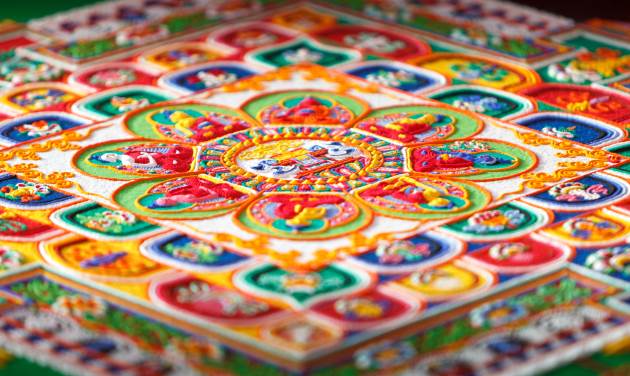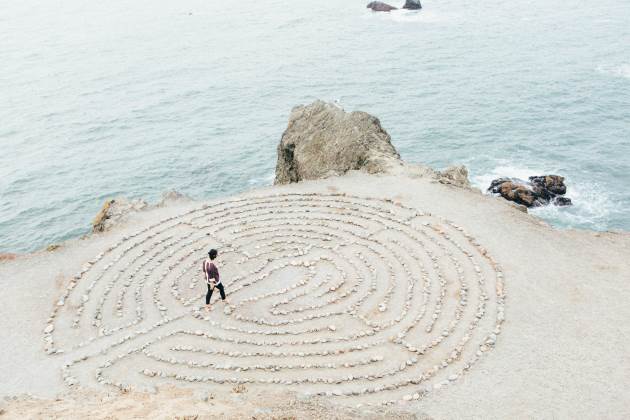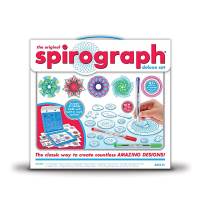Mandalas are one of the most popular designs for coloring books today. It’s estimated that roughly 64.8% of all coloring pages feature mandalas (statistic made up for purposes of this article). But where did this art form come from? Why are they such a mainstay of the coloring world? Why are they so darn fun to color in? Fear not, for we will answer all these questions and more in the paragraphs to come.
Coloring Mandalas Throughout History
Believe it or not, some of the first recorded mandalas are over two thousand years old! This art form has a rich history and a following that is still active and thriving. It spans from the ancient Hindu and Buddhist artists of the first century (and earlier) to the coloring book illustrators and colorists who are so fond of them today.
The First Mandalas
According to Wikipedia, the mandala originated as a Hindu ritual symbol that represented the universe. They are used in Hindu meditative rituals as a means of focusing the mind.
Mandalas also play an important role in Buddhism. Many famous Buddhist monasteries feature mandala designs in their architecture. The Tibetan Vajrayana monks create intricate mandala designs using colored sand. Even though they spend hours and hours creating these mandalas, the monks wipe the sand away when they are finished to reflect on the impermanence of the material world.

A False Alarm For Christians
You might have heard that mandalas oppose Christian beliefs; this is simply not true. A large portion of Christian imagery takes cues from the mandala design. Many cathedral rose windows feature elements of the mandala, as well as the dromenon on the floor of the Chartes Cathedral.
Mandalas Today
Eventually the religious symbol evolved into an artistic design. The original Hindu term is now used to reference a much broader scope of imagery. Mandalas can now be found in the realms of art, architecture, fashion, spirituality, and wellness. While they still have significant religious and spiritual roots, mandalas have had a profound impact on the art world.
Today, many coloring books feature mandala coloring pages. Some do so exclusively. Why is the coloring world so in love with mandalas? Aside from their relaxing nature, mandalas are easy to color, and the balance and symmetry of the page make for a very satisfying end result.
Benefits of Mandalas
Are mandalas really more stress-relieving than other coloring pages? That likely depends on the mandala you’re trying to color; a mandala page with a thousand tiny details is arguably more stressful than a simpler coloring page. Still, there are a few reasons why mandalas are considered anti-stress.

Balance
As mentioned above, mandalas originated as microcosmic representations of the universe. The balance found in mandala designs represents the order within the universe. Many people find that coloring mandalas helps them stay calm and find order when they feel overwhelmed by chaos.
Growth
One popular method for coloring mandalas is to start at the center and color outwards. Filling in the center section of a mandala is a small coloring victory in itself, and each section you fill in after that just makes the mandala more beautiful. Many colorists struggle to find where to start on other types of coloring pages. Other coloring designs can feel incomplete until the entire page is filled in. With a mandala, it is easier to reflect on the beauty of each piece as you complete it from the inside out.
Pre-Decision
Choosing a color palette is hard work. With other types of pages, deciding where to place each color can be even harder, and definitely gets stressful. The mandala’s symmetry helps by making many of these decisions for you. When you fill in one detail, it likely corresponds to several other details on the page, saving you from having to make color choice. This helps you take your mind off of your coloring and simply enjoy it for what it is.
How To Color a Mandala
There’s no right or wrong way to color a mandala, but there are a few tips we can share to make it a little simpler for you.
Inside-Out vs Pie Pieces
We’ve already mentioned the benefits of filling in mandalas from the inside out, but there’s another method that works well too. Coloring a mandala in “pie pieces” means that you color in each triangular symmetrical section one at a time. When you use this method, you can decide how to lay out all of your colors for the page while only filling in a fraction of it. Most mandalas have either four, six, or eight identical symmetrical sections; if you fill in one of these sections first, you won’t have to decide on which colors to use for the other sections. This way you can just let your mind relax while your body colors.
Color With Care
Just because mandalas are symmetrical doesn’t mean the colors have to match symmetrically. Still, this is the way most colorists choose to fill them in. If you decide to use symmetrical colors, be mindful of the details; one color mistake can turn your stress-relieving mandala into a stress-inducing one!
Best Mandala Coloring Books
This is really a matter of personal preference. There are tons of coloring books that have nothing but mandalas, and there are several others that have a few mandalas mixed in with other types of pages. Even Johanna Basford slipped a few mandalas into Secret Garden and Lost Ocean.
A high-quality mandala coloring book will likely share the same traits as any other good coloring book:
- Thick page stock
- Single-sided
- Thick and thin line variation
- Perforated pages for removal
- Spiral-binding
Where to Find Mandala Coloring Pages
Amazon is most colorists’ go-to source for new coloring books. You should be able to find more mandalas than you could ever color on that site. Still, there are several independent artists who create mandalas to color. They usually release them on their website or sell them page-by-page for colorists to print out at home.
If you need a quicker fix than that, you can head out to Barnes & Noble (or any other bookstore), the Dollar Store, Walgreens, Target, Walmart – nowadays it seems like there’s nowhere to hide from coloring books! If none of those choices work for you, why not try making your own mandala?
Making Your Own Mandala
While they seem to be such an intricate weaving of patterns, mandalas are surprisingly easy to create. There are several different methods and tools you can use to make your own mandala.
Mirror Method
Remember the pie piece mandala coloring method? There’s a similar way to draw your own mandalas. Start at the center of a piece of paper, and draw one line out to the nearest edge. Now draw another line out from the center; make sure that the angle between the two lines will evenly factor into 360, otherwise your mandala will not be symmetrical. Use a compass to measure this angle before drawing the second line. We’ve included a table of common measurements to help.
| Angle | # of Pie Pieces |
|---|---|
| 30 degrees | 12 |
| 45 degrees | 8 |
| 60 degrees | 6 |
| 90 degrees | 4 |
| 120 degrees | 3 |
Once you’ve drawn your lines, you can begin filling the space between them with your design. To get an idea of how your mandala will look, take two mirrors and line them up along either line so that they face one another and meet at the center of the page. Look into the mirrors to see your mandala in the reflection.
Once you are happy with your pie piece design, it is time to copy it several times to create the full mandala. Place your pie piece design under another sheet of paper and begin tracing. Once you are down, rotate your pie piece design and begin tracing the next section of your mandala. Repeat until you make it all the way around your mandala. Depending on your design and personal preferences, you might have to flip your pie piece to ensure that the mandala is perfectly symmetrical.
Spirograph
One really neat tool for creating mandalas is called a spirograph. Traditional spirographs resemble a small gear that fits inside a larger gear ring. The inner gear has holes that will fit the tip of a pen or pencil. As the inner gear spins within the outer gear ring, it guides your pencil, drawing perfect, mesmerizing designs in the process. Depending on the size of the spirograph and the position of the pencil holes, there are countless variation of mandalas to create.
You can use Inspirograph to test out your spirograph designs online.
Mandala Crash Course Complete
Congratulations! You are now a master of the mandala. You’ve learned their origins, why we love to color them, and even how to make your own. The only thing left to do is to get out there and start coloring some yourself!
If you use any of our tips, be sure to share your work on the ColorGaia Facebook Page. Happy Coloring!


 Spirograph
Spirograph
